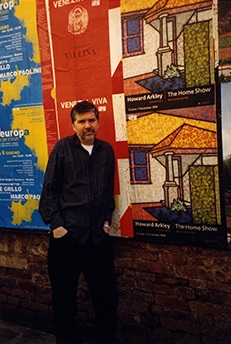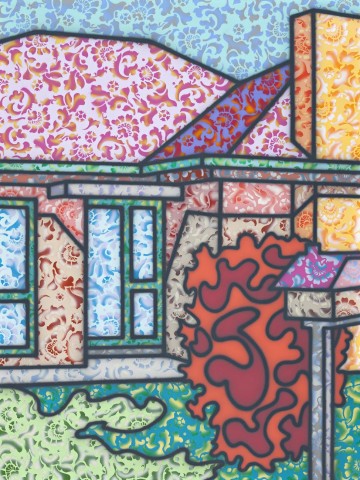FLORIATED ADDRESS, 1995
HOWARD ARKLEY
synthetic polymer paint on canvas
203.0 x 153.0 cm
signed, dated and inscribed verso: Name Howard Arkley / Title Floriated Address / Date 1995 / Size 203 x 153 cm / Medium Acrylic on Canvas
signed and dated on stretcher bar verso: Howard Arkley 95
Bellas Gallery, Brisbane
Private collection, Brisbane, acquired from the above in 1995
Bellas Gallery, Brisbane
Private collection, Sydney, acquired from the above in May 2000
Howard Arkley Online Catalogue Raisonné: [http://arkleyworks.com/blog/2019/07/31/floriated-address-1995/] (accessed 31/07/19)
Floriated Residence, 1994, synthetic polymer paint on canvas, 203.0 x 153.0 cm, The Vizard Foundation Art Collection of the 1990s, on loan to the Ian Potter Museum of Art, University of Melbourne, Melbourne
Floral Exterior, 1996, synthetic polymer paint on canvas, 174.5 x 134.5 cm, in the collection of the National Gallery of Australia, Canberra
‘The day I came back, I realised what I needed to do: I was Australian and had to deal with that. This sounds like something Sidney Nolan might have said in 1945, but it’s true. I was astounded because, like many other artists, I had denied it. I had left the suburbs never to return.’1
Renowned as the painter of Australian suburbia, Howard Arkley made the depiction of local vernacular architecture his own. Having begun his career as an abstract artist, creating images that miraculously incorporated his love of line and pattern within a cool Minimalism, Arkley’s revelation came after returning home following residencies in Paris and New York, as well as extended travel through Europe, in the late 1970s. In Paris he had photographed hundreds of decorative doorways, fascinated by the sinuous Art Nouveau designs of the early twentieth century and the stylised geometry of Art Deco, and visiting his mother in suburban Melbourne upon his return, discovered an Australian version literally at the front doorstep.
‘I pressed the buzzer and I’m standing there waiting for the door to open and I see it. This flywire security door was like a revelation. There’s very few times the light goes on – like in a cartoon. This was it. It reminded me of Paris, but it was so different. We’ve got our own Parisian doorways … so I got my camera and photographed the whole street – every flywire door.’2
Arkley’s lightbulb moment didn’t lead directly to the production of suburban house images, but initially opened up the sources of his bowerbird-like collecting of visual material to include details drawn from the domestic environment. Alongside the popular culture references that filled the pages of Arkley’s scrapbooks – comics, children’s book illustrations, advertising material, details from newspapers and magazines, and so on – were added images of the ubiquitous flywire door, patterns of Laminex and the linoleum that covered the kitchen floor. At Prahran College in the early 1970s Arkley was introduced to the airbrush, a tool that was to become his trademark, by teacher and fellow-artist Fred Cress. Associated with the production of commercial rather than fine art, the airbrush was a radical choice and at first, Arkley was criticised for using it. Its particular qualities however appealed to Arkley – the solid line and distinctive blurry edges, and perhaps the speed with which it allowed him to get his imagery down – who later said, ‘The airbrush is neutral, I like that. I like the fact that the imagery looks like it is printed; it looks like a reproduction of a painting, rather than a painting’.3
HOWARD ARKLEY (1) - Supplementary Image.jpg

The making of Primitive, 1981, (private collection, Melbourne) a vast work on paper produced during an all-night session of frenetic, creative energy, marked a move towards the use of more figurative imagery in Arkley’s art and the first house painting, Suburban Exterior – inspired by an image from a children’s comic book and real estate advertising – was shown in his 1983 exhibition at Tolarno Galleries in Melbourne. It was several years later that this subject became a more primary focus of Arkley’s oeuvre and that major works including Triple Fronted, 1987 (Art Gallery of New South Wales, Sydney) and the diptych, House and Garden Western Suburbs, Melbourne, 1988 (National Gallery of Australia, Canberra) began to be produced.
There were few precedents of this new subject within Australian art. John Brack’s images of 1950s suburban life, deadpan depictions that typically made viewers laugh, despite the artist’s humanist motivations, are the most obvious and later, artists including Robert Rooney, and others of Arkley’s generation such as Jenny Watson, Aleks Danko and Bill Henson, had all found inspiration in the familiarity of suburbia. While some found the suburbs soulless places where nothing ever happened, some saw beauty (think of the glistening tiled rooftops of Henson’s mid-1980s photographs), and others detected a dark underbelly behind the well-tended gardens and repetitive domestic facades. Arkley’s own attitude towards the suburbs was ambivalent and changeable. In 1989 he described his subject as reflecting ‘the suppressed Australian experience in the suburbs ... not very expressive, and tight … it’s all neat and clean, the lawns are all mowed’.4 Almost a decade later, by which time he and his partner, Alison Burton had moved to live in Oakleigh, an outlying eastern suburb of Melbourne, he challenged an interviewer’s assertion that suburban life was tedious, declaring, ‘It’s a myth, an elitist view. I’m having a great time’.5 As John Gregory has written, ‘depending on his state of mind, Arkley could see suburbia in either golden or melancholy light … [and] the contradiction itself should be seen as significant, unveiling a struggle in the artist’s own psyche’.6
Whatever his feelings about the suburbs, the subject offered Arkley the artist fresh material with which he could say something meaningful – and he believed, inevitable – about the country in which he lived. While few had contemplated the idea that the suburban vernacular could be worthy of serious aesthetic consideration,7 Arkley realised that this was a subject through which he could forge a new tradition of the Australian ‘landscape’ based on the urban environment in which most of the population lives. He explained, ‘What I’m trying to do, I believe, is explicitly the right thing, and if it isn’t me it will be someone else. It has to be done. And we’re not talking just about doing the work, but about inspiring a whole generation of future artists to delve into this area and exploit it. It looks like overstatement, like it’s obvious, and I would much rather make some subtler art, but I don’t think it will get across’.8 Arkley continued, ‘What I would actually like to do is equivalent to when you’re driving along in the country and you look at the landscape and you say “Oh, there’s a Fred Williams.” You change the way people see it. And you make people look at it. In the same way that David Hockney has changed the way that people can look at Los Angeles, the swimming pools. Hollywood’s Mulholland Drive, good God, that could be Lower Templestowe Road! I just want people to see it’.9
Painted in 1995, Floriated Address is part of a group of works in which Arkley’s use of decorative pattern and contrasting colour reaches a spectacular crescendo. Merging an aspect of domestic interior decoration with a view of the exterior, a stencilled ornamental pattern (borrowed from wallpaper and fabric designs) covers every element of the double-fronted house, as well as the lawn, low-lying plants to the left, and letterbox. Each area is demarcated by Arkley’s black airbrushed line and features variations of multiple colour combinations, the single element in the painting not decorated in this way, a tall orange bush behind the letterbox. The visual intensity of this painting and others, including Floral Exterior, 1996 (National Gallery of Australia), reveals Arkley in his element, balancing colour – sometimes jarring but always brilliant – pattern and detail within an image that is at once familiar, but in his hands, utterly transformed. The description of viewing the closely related work, Floriated Residence, 1994 (The Vizard Foundation Collection of the 90s, on loan to the University of Melbourne) as ‘something like a sensation of awe in the face of our ordinary domestic environment’ is equally pertinent here where, again, ‘the patterns heighten the mystery, like a series of lace veils, encouraging the fascinated eye to probe the subtle and exotic shifts of hue and curlicue, turning the humble house into a temple of ornamental intricacy and paradoxically fabulous craftsmanship’.10
In 1999 Arkley represented Australia at the 48th Venice Biennale with The Home Show, introducing his unique take on the Australian suburbs to an international audience at the world’s most important contemporary art exhibition. The Home Show was ‘the culmination of [his] suburban enterprise, fulfilling a long-standing ambition to transform an entire exhibition into a stylised simulacrum of an Australian suburb’.11 Nine exterior paintings (including Floriated Residence and Houseomorphics, 1996, both closely related to the current painting) comprised a ‘Residential Subdivision’ on the entrance level and on the floor below, paintings from the Outside-Inside-Outside and Fabricated Rooms series formed a striking panorama of vividly coloured interiors, almost twenty metres long. Widely regarded as one of the highlights of the 1999 Biennale,12 the exhibition was followed by a successful commercial show in Los Angeles and increasing international attention which acknowledged the power of Arkley’s vision beyond its antipodean context – what the art critic, Marco Livingstone, described as ‘the purely pictorial dynamic on which the success of each picture depends … it is [ultimately] as paintings that they finally weave their spell’.13
1. The artist quoted in Crawford, A., & Edgar, R., Spray: The Work of Howard Arkley, Craftsman House, Sydney, 1997, p. 26
2. ibid.
3. ibid., pp. 14-15
4. Gregory, J., Carnival in Suburbia: The Art of Howard Arkley, Cambridge University Press, Port Melbourne, 2006, p. 10
5. ibid.
6. ibid.
7. Morrell, T., ‘Howard Arkley: The Home Show’ in Howard Arkley: The Home Show, Australian Pavilion, 48th Venice Biennale, exhibition catalogue, Australian Council for the Arts, Sydney, 1999, p. 15
8. Crawford & Edgar, op. cit., p. 89
9. ibid.
10. Gregory, op. cit., p. 75
11. Gregory, J., Arkley Works, http://arkleyworks.com/blog/2009/11/21/howard-arkley-the-home-show-venic..., accessed 22 July 2019
12. ibid.
13. Livingstone, M., ‘Some Kinds of Love: Howard Arkley’s Urban Suburban Environment’ in Howard Arkley: The Home Show, op. cit., p. 9
KIRSTY GRANT
